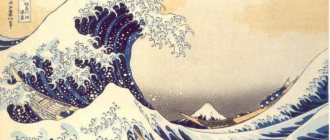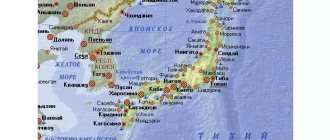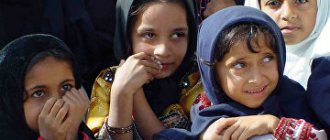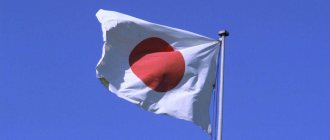Japan is an island country located in the Pacific Ocean. The country is known for its densely populated cities and advanced technology , vibrant culture and rich history .
History of Japan in the twentieth century. was eventful . First half of the twentieth century. marked by several wars, an economic crisis , and the infamous bombings of Hiroshima and Nagasaki. In the second half of the twentieth century. The life of the Japanese entered a more peaceful direction. The country's economy grew and developed, and foreign policy relations improved.
Main events in Japan during the twentieth century.
- 1904–1905 war with Russia. War broke out between Russia and Japan over control of Manchuria, Korea and the Yellow Sea. The Japanese Empire was victorious in this war. The southern part of Sakhalin and the Liaodong Peninsula were given to her. Korea came under the Japanese zone of influence. Russian troops were withdrawn from Manchuria.
- 1910 Korea annexed. As a result of the Russo-Japanese War, Korea found itself under the protectorate of Japan. But this was not enough; the Japanese Empire demanded more. In 1910, a treaty was signed according to which Korea joined Japan. In fact, for 35 years it turned into a Japanese colony. A strict authoritarian policy was pursued towards the inhabitants of the Korean peninsula. Throughout the colonization period, Koreans were discriminated against.
- 1914–1918 participation in the First World War . During the First World War, Japan acted on the side of the Entente. As a result of the victory of Japanese troops, the Chinese province of Shandong, which before the war was under German influence, came under the protectorate of Japan. The Japanese Empire increased pressure on China, demanding exclusive rights for the Japanese to live, rent land, conduct trade, and mine mineral resources on the territory of the Republic of China. China was also prohibited from leasing bays, harbors and islands along the Chinese coast. The Entente countries accepted Japan's aggressive policy towards China in exchange for assistance in the war.
- 1923 strong earthquake. In September 1923, an 8.3 magnitude earthquake occurred. As a result, the cities of Tokyo and Yokohama were destroyed. About 200 thousand people died. Material damage from the natural disaster amounted to about $4.5 billion, which at that time was equal to two of the country's annual budgets. This was the most destructive earthquake in the history of Japan.
- 1929 world economic crisis. The economic crisis began in 1929 with a stock market crash in the United States and affected the entire capitalist world, including Japan. Prices for the main imported goods from Japan - raw silk, as well as other goods: tea, tobacco, rice, fell sharply. The turnover of trading companies has halved, which has led to layoffs and reduced wages. There were strikes by industrial and agricultural workers and students. The Japanese Empire found itself on the edge of an economic abyss.
- 1931 invasion of Manchuria (China). Manchuria, due to its advantageous strategic location and natural resources, has long attracted Japan. In September 1931, Japanese troops captured cities in the area of the South Manchurian Railway, and an operation was also carried out to disarm the Chinese garrisons. The head of Manchuria did not resist, hoping that the League of Nations would help resolve this conflict. However, the international organization did not take any action to suppress the actions of the aggressor troops. A fictitious state of Manchukuo was created on the territory of Manchuria. A little later, another captured Chinese province of Zhehe was annexed to Manchukuo. When the League of Nations commission finally recognized the fact of Japanese aggression, Japan simply withdrew from this organization.
- 1936 Anti-Comintern Pact signed . According to the document, Japan and Germany agreed on close cooperation in the fight against world communism, and the parties also agreed not to enter into any agreements with the USSR. Germany, in turn, recognized the pro-Japanese regime in Manchuria.
- 1937 Beginning of the second Sino-Japanese War. In 1937, Japan launched active military operations against China. Major Chinese cities were captured: Beijing, Shanghai, Guangzhou. This war lasted until 1945, running parallel to the events of World War II.
- 1940 signing of the “Three Power Pact”. In 1940, Japan, together with Germany and Italy, signed the “Three Power Pact” document. According to the document, the countries pledged to support each other in the political, economic and military spheres. The Japanese Empire recognized Germany and Italy's right to create a new order in Europe. Italy and Germany recognized Japan's dominance in East Asia. Later, Hungary, Bulgaria, Spain, and Finland joined the agreement. This pact completed the formation of an aggressive fascist bloc.
- 1941 Japanese attack on Pearl Harbor. In 1941, Japanese troops attacked the American military base at Pearl Harbor, located in the Pacific Ocean. From this point on, Japan entered World War II. The Japanese fought on the side of Nazi Germany. The military operations of the Japanese army during this period were quite successful. The territory from India to New Guinea came under its control.
- 1942 Battle of Midway. In June 1942, a major naval battle took place between the Japanese and US fleets. The battle took place near Midway Atoll in the North Pacific Ocean. In this battle, US troops won. After this, the Empire of Japan was forced to stop offensive operations and switched to defensive actions.
- 1942–1945 bombing of Japan. For 4 years, Japan was subjected to bombing by the Allied forces. The most destructive was the bombing of Tokyo in March 1945. The bombing lasted 3 hours, 1665 tons of incendiary bombs were dropped on the city. About 100 thousand residents died, half of the capital's buildings were completely destroyed.
- 1945 bombing of Hiroshima and Nagasaki. In August 1945, US aircraft dropped atomic bombs on the Japanese cities of Hiroshima and Nagasaki. About 300 thousand residents of these cities died. Another 150 thousand died over the next 5 years from diseases caused by a nuclear explosion. In August 1945, the USSR and Mongolia declared war on Japan. Soviet troops entered the territory of Manchuria, Korea and South Sakhalin. As a result, in September 1945, the act of surrender of Japan in World War II was signed.
- 1945–1952 occupation of Japan by Allied forces. All questions regarding diplomacy and trade were resolved through American forces. Japan lost all its colonies. The state was prohibited from having its own troops. During this period, the country's economy was brought to the pre-war level. In April 1952, a decision was made to withdraw Allied troops from Japanese territory.
- 1956 was marked by the normalization of relations between Japan and the USSR. In the same year, the country joined the United Nations (UN).
- 60s XX century At this time, the country's economy began to rise. Industry, shipbuilding, steel production, and radio engineering developed. In 1964, the Olympic Games were held in Japan. This became a kind of symbol of the return of the newly demilitarized Japan to the world community.
- 1972 was marked by the normalization of relations with China. In September 1972, the Japanese delegation established diplomatic relations with the People's Republic of China. The “Treaty of Peace and Friendship” was concluded, agreements on air and sea communications and trade were signed.
- 80s XX century This period passed in a calm manner for Japan. There were no shocks in politics or social life. The Japanese economy developed quite steadily, with GDP growing at 4% per year. But December 1989 brought unpleasant surprises. Japanese banks found themselves hostage to financial speculation, which led to a banking crisis and a stock market crash.
- 90s XX century marked by a complete stop in the economic growth of the Japanese economy and an increase in the unemployment rate. Japan was able to emerge from the protracted economic crisis only in the early 2000s. In 1995, an earthquake occurred in the area of the cities of Osaka and Kobe. The magnitude of the earthquake was 7.3. The disaster claimed the lives of 6.5 thousand people, 640 thousand buildings were destroyed. Also in 1995, members of the Aum Shinrikyo sect carried out a terrorist attack. Sarin gas was sprayed into the Tokyo subway. 20 people died, more than 5 thousand people received poisoning of varying degrees of severity.
1995 earthquake
Japan during and after World War I
As a result of the First World War, the foreign policy situation developed very favorably for Japan.
The great human and material losses suffered during the war in European countries put an end to the old “wild” imperialism. The West weakened its attention to distant regions, which Japan immediately took advantage of. Note 1
During the war, the Japanese islands did not suffer military destruction and were not disturbed by any national disasters. During 1914-1918 the country has significantly strengthened its political position in the Southeast Asian region.
By the time the war ended, Japanese troops were located in China, Manchuria, Korea and the Russian Far East.
Finished works on a similar topic
- Coursework Japan at the beginning of the 20th century. 480 rub.
- Abstract Japan at the beginning of the 20th century. 280 rub.
- Test Japan at the beginning of the 20th century. 250 rub.
Receive completed work or specialist advice on your educational project Find out the cost
Military orders contributed to the vigorous development of the economy. Preoccupied with the war, Western countries stopped supplying most of their goods to Southeast Asia. This allowed the Japanese economy to double its industrial output during the war. The country was able to significantly expand markets for its goods in China and almost completely monopolize the sphere of regional maritime transport.
Reasons for the breakthrough
By April 1952, the Japanese economy had undergone a number of transformations and had practically reached its pre-war level. Today, the phenomenon of an astonishing leap in the economy of the Land of the Rising Sun is commonly called the “Japanese economic miracle.” The country experienced incredible economic growth from 1950 to 1973.
Surprisingly, Japan experienced economic growth of 10% annually during this period of time. No country in the world could boast of such indicators, and in the history of Japan, the heyday of the economy occurred in the “ golden sixties ,” when the standard of living of the population was one of the best on the planet.
What factors played a key role in the process of economic growth?
- Low taxes allowing businesses to develop in all sectors;
- Introduction of the latest technologies and techniques borrowed from foreign colleagues;
- Constant protection of workers at enterprises, thanks to the activities of trade unions;
- Land reform of 1947, during which peasants became land owners;
- Regulation of currency within the state;
- Tighter quality control of manufactured products.
The combination of these factors stimulated Japan's technological breakthrough and ensured partnerships between the government and entrepreneurs. New jobs appeared, wages increased annually, and trade unions actively fought for the rights of the working population of Japan.
"Abenomics", or a new stage in the economic life of Japan
Today Japan is experiencing an economic crisis. Since the beginning of 2012, Japanese Prime Minister Shinzo Abe has introduced a number of reforms aimed at getting the country out of the crisis. The prime minister's policy was called "Abenomics" .
The Japanese proudly recall the period of the “economic miracle” and believe that they will soon again be able to claim the title of the country with the best economic indicators. Shinzo Abe proposed three main directions for reforming the country:
- Monetary stimulus;
- Carrying out structural reform;
- "Flexibility" in the tax system.
These areas are called the “three arrows” and are aimed at transformations in the fields of agriculture, education, pharmaceuticals, tourism and finance. According to Abe's plan, the country should increase international trade, reduce taxes for businesses and renew tourist interest in the Land of the Rising Sun.
In the first two years, Abenomics did not bring the desired results. For example, GDP growth was only 1.7% instead of the planned 3%. The minister himself claims that the rapid decline in the number of economically active population is to blame. The nation is aging, and due to a labor shortage, the effectiveness of reforms is in question. However, the Japanese economy is the third largest in the world, and it has every chance of ousting its competitors and becoming a leader.
The "Japanese Economic Miracle" is one of the best pages in the history of Japan, when its people showed hard work and patience on the way to restoring the country's prosperity. The introduction of the latest technologies, a fundamentally new approach to work, tightening control over the circulation of funds within the country and low taxes managed to make the Land of the Rising Sun a world leader in the 60s of the 20th century.
The period of economic recovery laid the foundation for scientific and technological progress, and today Japan is one of the leaders in terms of education and public provision of the population.









